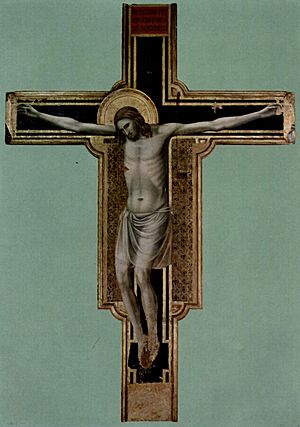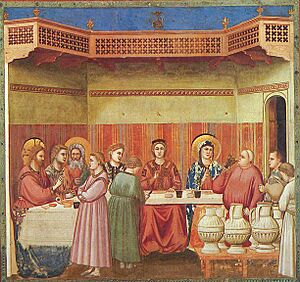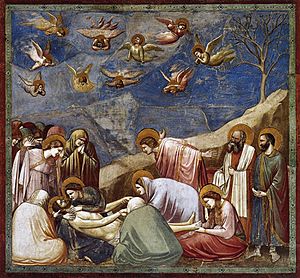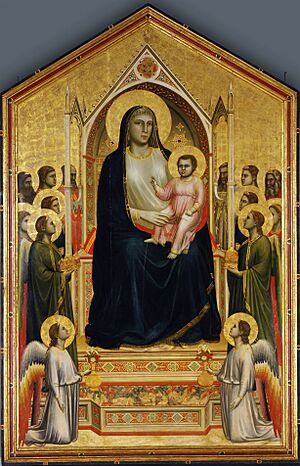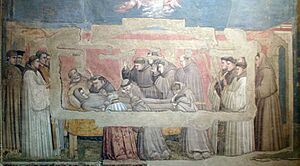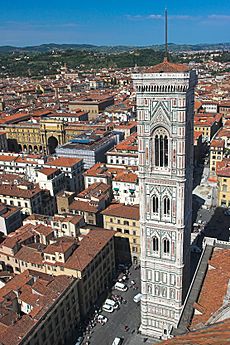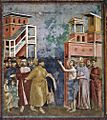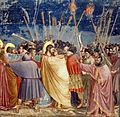Giotto facts for kids
Quick facts for kids
Giotto
|
|
|---|---|
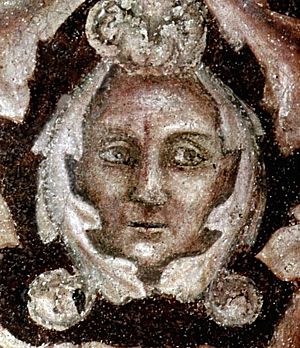
This face in the decorations of the Peruzzi Chapel, might be Giotto's portrait of himself. (digitally restored)
|
|
| Nationality | Italian |
| Known for | Painting, Fresco |
|
Notable work
|
Scrovegni Chapel frescoes, Campanile |
| Movement | Gothic |
Giotto di Bondone (born around 1267, died January 8 1337), known simply as Giotto, was a famous Italian painter and architect. He came from Florence. Many people believe he was the very first great artist of the Italian Renaissance. This was a time when art, science, and learning became very important in Europe.
A writer named Giovanni Villani, who lived at the same time as Giotto, said that Giotto was the "king of painters." He wrote that Giotto made all his painted figures look alive. Villani also mentioned that the city of Florence paid Giotto a special salary because he was so talented.
Later, in the 1500s, a biographer named Giorgio Vasari wrote about Giotto. Vasari said that Giotto completely changed painting. Before Giotto, artists often copied old styles. But Giotto started drawing people and things as they looked in real life. This new way of painting helped lead to the amazing art of later Renaissance painters like Leonardo da Vinci.
Giotto's most famous work is the beautiful decoration of the Scrovegni Chapel in Padua. He finished these paintings around 1305. This building is sometimes called the "Arena Chapel" because it was built on the site of an old Roman arena. The chapel is covered in frescoes, which are paintings made on wet plaster. These frescoes show the life of the Virgin Mary and the life of Christ. They are considered one of the greatest artworks of the Early Renaissance.
Even though Vasari wrote about Giotto's life, we don't know if all his stories are true. Vasari wrote more than 200 years after Giotto died. We only know two things for sure about Giotto. In 1334, the city council of Florence chose Giotto to design the bell tower next to Florence Cathedral. We also know for certain that Giotto painted the "Arena Chapel." But we aren't sure where he was born, who taught him, what he looked like, or where he was buried.
Contents
Giotto's Early Life
Where and When Was Giotto Born?
Giotto was probably born in a farmhouse on a hilltop, maybe in a place called Colle di Romagnano. His father was a respected man named Bondone. Giotto's name might have been a nickname, like "little Ambrose" (Ambrogiotto) or "little Angelo" (Angelotto).
We know Giotto died in 1337. The year of his birth, 1267, comes from a poem by Antonio Pucci. Pucci was a town crier in Florence. He wrote that Giotto was seventy when he died. However, some people think Pucci just used "seventy" because it rhymed in his poem. Giotto might have been a different age when he passed away.
Giotto's Artistic Start
In his book Lives of the Artists, Giorgio Vasari tells a famous story about Giotto. He says Giotto was a shepherd boy, who was cheerful and smart. One day, the great Florentine painter Cimabue saw Giotto drawing pictures of his sheep on a rock. The drawings looked so real that Cimabue asked Giotto's father if he could take the boy as an apprentice. An apprentice learns a skill by working with a master.
Many art historians today think this story is just a legend. They believe Giotto's family was quite wealthy. They likely moved to Florence, and Giotto was sent to Cimabue's workshop to learn painting.
Vasari also shared other stories to show how clever and funny Giotto was. He wrote that when Cimabue was away, Giotto painted a fly on a painting his master was working on. When Cimabue returned, he tried several times to brush the fly off, thinking it was real!
Another story from Vasari is about the Pope. The Pope wanted to see if Giotto was a good artist for important paintings. He sent a messenger to ask Giotto for a small picture. Instead of painting a detailed picture, which would take days, Giotto quickly drew a perfect red circle. It looked as if he had used a compass. Giotto told the messenger to give that to the Pope.
Giotto's Career and Famous Works
Early Paintings and Influences
Giotto's teacher, Cimabue, was one of the two most famous painters in Tuscany. Cimabue worked in Florence, while the other famous painter, Duccio, worked in Siena. Around 1280, Giotto and Cimabue traveled to Rome. In Rome, Giotto saw paintings by Pietro Cavallini and sculptures by Arnolfo di Cambio. These artists created figures that looked much more realistic and three-dimensional than the paintings by Giotto's teacher. This new style likely influenced Giotto.
Later, Giotto's teacher Cimabue went to Assisi to paint large frescoes in the "Upper Church" of the Basilica of St. Francis. For a long time, people believed Giotto also painted a famous series of frescoes there, showing the "Life of St. Francis." However, modern art historians now think these paintings were done by several different artists, probably from Rome. It's unlikely any were by Giotto.
Vasari wrote that Giotto's earliest works were for the Dominican Friars in the Church of Santa Maria Novella in Florence. These include a fresco of the Annunciation and a huge hanging Crucifix, about 5 meters (16 feet) tall, painted around 1290.
In 1287, when he was about 20, Giotto married Ricevuta di Lapo del Pela, also known as "Ciuta." They had many children, perhaps eight. One of their sons, Francesco, also became a painter. Giotto's fame grew, and he was asked to work in Rome, Padua, and Rimini. His Crucifix can still be seen in the Church of St Francis in Rimini. Giotto became wealthy enough to buy land in Florence, which suggests he ran a large art workshop.
The Amazing Scrovegni Chapel
Giotto's most famous paintings are the frescoes in the Scrovegni Chapel in Padua. He painted these between 1303 and 1310. The Scrovegni Chapel is often called the Arena Chapel because it stands on the site of an old Roman arena.
A rich man from Padua, Enrico degli Scrovegni, hired Giotto to paint the chapel. Enrico built the chapel to pray for his dead father's soul. It was next to an old palace he was fixing up. The palace is gone now, but the chapel remains. The outside of the building is very plain, made of reddish-pink bricks.
The inside of the chapel is also simple in its structure. It's a long room with a chancel (a space for the priest) at one end, an arched roof, and windows on one side. The walls are covered with three layers of pictures. The main idea of these pictures is God's Salvation of people through Jesus Christ.
Above the main door, there is a large painting of the Last Judgement. At the other end, on either side of the chancel archway, are paintings of the Annunciation. One side shows the Virgin Mary, and the other shows the Angel Gabriel bringing her the news that she will have a son, Jesus.
Around the walls, starting from the top, are scenes telling the life of the Virgin Mary. Below them, in two layers, are stories from the life of Jesus. There are 37 scenes in total.
What Makes These Paintings Special?
Giotto's teacher Cimabue painted in an older, Medieval style. But Giotto's paintings look very different. The writer Giorgio Vasari said that Giotto brought a complete change to painting, making it much more natural. Giotto had seen the paintings of Pietro Cavallini and some Ancient Roman sculptures during his visit to Rome. He also saw the sculptures of Arnolfo di Cambio in Florence. These sculptures had solid, natural-looking figures, not long and thin like many Medieval figures.
The figures Giotto painted are solid and look three-dimensional. Their bodies, faces, and actions look very natural because Giotto drew them by observing real people. The clothes on his figures don't form a beautiful pattern like in Cimabue's paintings. Instead, they fit the figures and hang naturally, like real clothes. This more natural way of showing people was started by Pietro Cavallini, but Giotto developed these ideas much further.
In the Scrovegni Chapel paintings, each scene looks like a shallow stage with actors on it. There are always some buildings or a landscape, like a rocky hill, to show where the action is happening. The figures in each scene are carefully placed so that you can imagine you are right there, watching the story unfold.
Giotto was a brilliant storyteller. He showed the emotions of the characters in each painting through their faces and their "gestures" (body movements).
- One painting shows old Joachim returning to the hillsides, looking sad because he can't have children. Two young shepherds look sideways at each other, showing their thoughts.
- In the picture of Mary and Joseph traveling to Egypt, the people walking behind them seem to be gossiping.
- The most famous painting, "The Lamentation over the Body of Christ," shows the deep sadness of Jesus' mother and friends as they prepare his body for burial. On Earth, people are crying, while in Heaven, angels are roaring and shrieking, tearing their hair in grief.
A famous English art critic from the 1800s, John Ruskin, said that Giotto painted the Madonna, St. Joseph, and the Christ Child to look like an ordinary "Mamma, Papa, and Baby."
Giotto had students who copied his style, and many other artists were influenced by him. These painters include Guariento, Giusto de' Menabuoi, Jacopo Avanzi, and Altichiero. For the next hundred years, many churches and chapels were painted with scenes similar to Giotto's. The Scrovegni Chapel paintings were so famous that even artists like Michelangelo, who lived 200 years later, made drawings or copies of them.
From 1306 to 1311, Giotto was in Assisi, painting frescoes in the Lower Church. These paintings show The Life of Christ, the Teachings of the Franciscan Friars, and The Lives of the Saints.
In 1311, Giotto returned to Florence. In 1313, he went to Rome to design a mosaic for the front of the old St. Peter's Basilica. This mosaic was later destroyed when the building was taken down.
From 1314 until 1327, Giotto lived in Florence. During this time, he painted the famous altarpiece for the Ognissanti Church (Church of All Saints). This large tempera painting is called the Ognissanti Madonna. It is now in the Uffizi gallery, displayed next to Cimabue's Santa Trinita Madonna and Duccio's Rucellai Madonna. Giotto also painted a very large Crucifix to hang in Ognissanti Church.
The sculptor Lorenzo Ghiberti wrote that in 1318, Giotto began painting four chapels at the Church of Santa Croce. Rich families paid for these chapels, and they were named after them. Giotto painted the Life of St. Francis in the Bardi Chapel. He painted the Life of St. John the Baptist and the Life of St. John the Evangelist in the Peruzzi Chapel. The Peruzzi Chapel was very famous during the Renaissance. More than 150 years later, Michelangelo came to study Giotto's paintings there.
Giotto's Later Years
In the 1320s, Giotto painted two large altarpieces. The first was the Stefaneschi Triptych, which is now in the Vatican Museum. A triptych is a painting made of three panels. The second altarpiece is called the Baroncelli Polyptych. A polyptych has many parts, usually made as large altarpieces for important churches, often with big, carved gold frames.
Giotto traveled to paint in Rome, Naples, and Bologna. He always brought a group of students with him. Today, many of the frescoes he painted in these cities have been damaged or destroyed by dampness, earthquakes, wars, or when churches were torn down. Because Giotto was so famous, people often liked to believe that he painted the frescoes in their church. Many frescoes are probably by Giotto's students.
In 1334, Giotto was in Florence, where the magnificent new Florence Cathedral was being built. Giotto was made the chief architect and was given the job of designing a huge tower for the cathedral bells. This tower is called Giotto's Bell Tower. He started building it on July 18 1334, but it was not finished exactly to his original design.
As he grew older, Giotto became friends with two writers, Giovanni Boccaccio and Sacchetti. They both thought he was such an interesting and famous person that they wrote about him in their stories. The most famous writer of that time, Dante, also wrote about Giotto in his book The Divine Comedy. Dante said that Giotto was the greatest painter in the world, even better than his famous teacher, Cimabue.
Giotto's Burial Mystery
Giotto died in January 1337. Vasari wrote that Giotto was buried in Santa Maria del Fiore, the Cathedral of Florence. He said the spot was on the left of the entrance, marked by a white marble plaque.
In the 1970s, some bones were found under the paving near the spot Vasari described. In 2000, experts examined these bones.
The bones belonged to a very short man, just over four feet tall. In a fresco in the Church of Santa Croce, there is a figure of a man who is a dwarf (a very short person). People at that church have always said that this dwarf was Giotto himself. The bones found at the cathedral seem to support this story. Also, the bones had unusual chemicals like arsenic and lead, which were found in artists' paints from that time. After the bones were examined, they were reburied with great honor, as many believed they were the remains of the great artist. However, not everyone agrees with this belief.
Images for kids
-
One of the Legend of St. Francis frescoes at Assisi, the authorship of which is disputed.
-
Kiss of Judas, Scrovegni Chapel
-
Campanile di Giotto (Florence)
-
Engraving after a portrait of Dante by Giotto
See also
 In Spanish: Giotto para niños
In Spanish: Giotto para niños


